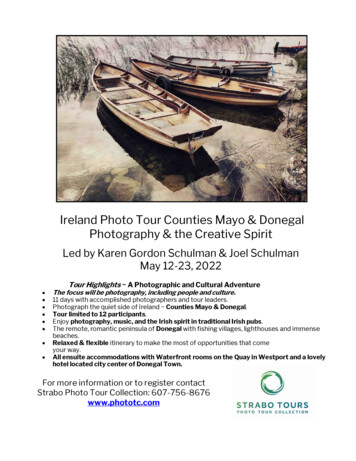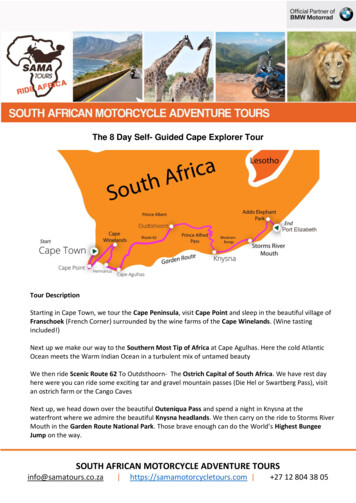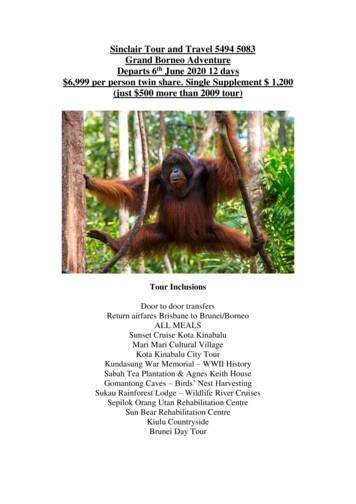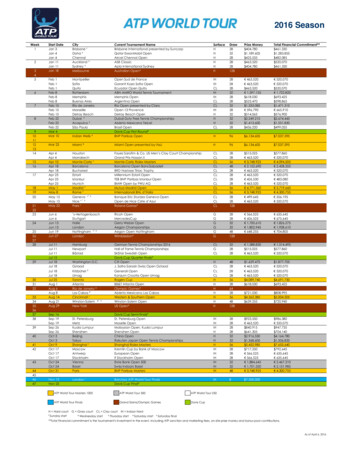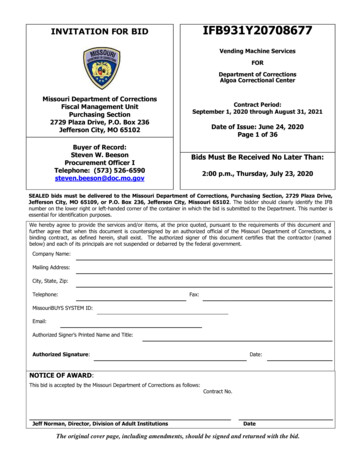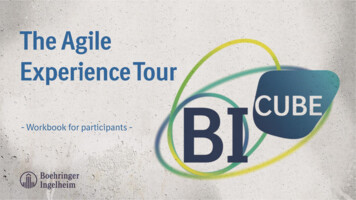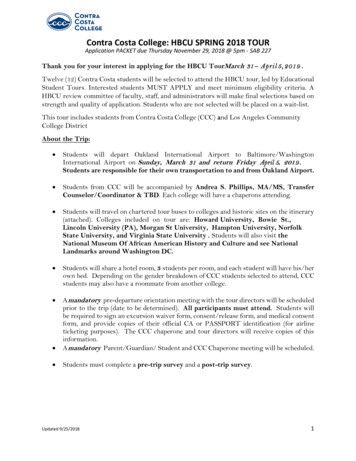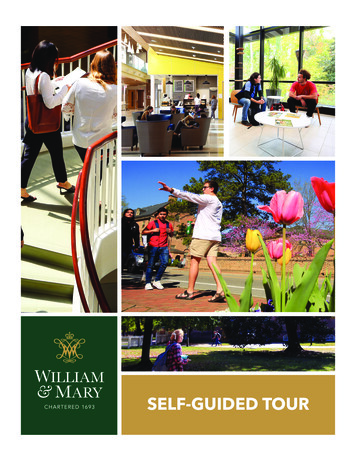
Transcription
SELF-GUIDED TOUR
William & Mary’s Class of 202564%Virginia Residents36%Non-VirginiaResidentsTop Represented States Outside of VirginiaMaryland, New Jersey, Pennsylvania,New York, Massachusetts, California,Connecticut, North Carolina, Florida, Illinois01-56-1011-2021-40over 40
Greetings, and welcome to William & Mary!Thank you for taking the time to come to our campus today, and all of us from the Officeof Undergraduate Admission hope you enjoy your time exploring and learning moreabout what William & Mary has to offer.The Office of Undergraduate Admission is normally open weekdays between the hoursof 8:00 am and 5:00 pm. We can be reached via email at admission@wm.edu or viaphone at 757-221-4223.To begin your tour with some history of William & Mary, the university was founded in1693 with a royal charter from King William III & Queen Mary II making it the secondoldest institution of higher education in the country. One of the most principal buildingson campus, the Sir Christopher Wren Building was built between 1695 and 1700 andis the oldest academic building still in use on a college campus today in the UnitedStates. Given its age and location, William & Mary has played an important role in thehistory and development of both Virginia and the nation. William & Mary has had threeAmerican Presidents attend, including Thomas Jefferson, James Monroe, and John Tyler.George Washington received his surveyor’s license from William & Mary and later servedas Chancellor. In addition, 16 members of the Continental Congress have attended, aswell as four signers of the Declaration of Independence, four Justices of the SupremeCourt, and countless members of Congress and government officials.William & Mary today is a moderate-sized university with around 6,400 undergraduatestudents and includes five different schools. Arts and Sciences, with both undergraduateand graduate sections, offers instruction in over 50 majors and minors, as well as in 12masters and 6 doctoral programs. The School of Education offers an undergraduatemajor in elementary education, a minor in educational studies, and graduate programsthat include 4 masters, 1 educational specialist, and 2 doctoral degree programs. TheSchool of Business Administration features both the traditional BBA and MBA degreesand also offers part-time and weekend programs for specially admitted candidates.From the Law School, both JD and LL.M. degrees are available. And finally, the School ofMarine Science, located a short 25-minute drive from the central campus, provides bothmasters and doctoral programs.Now that you are acquainted with William & Mary of today and the past, let’s begin yourtour. You have likely just left the Office of Undergraduate Admission and are ready to goto your first stop on campus. Please take the crosswalk to your right across JamestownRoad and proceed onto Old Campus. William & Mary’s main campus is broken up intothree separate portions: Old Campus, New Campus, and Historic Campus. You willbegin on Old Campus which is composed of the Sunken Garden and the six academicbuildings that surround it.WILLIAM & MARY SELF-GUIDED TOUR1
Washington Hall (1928) is the home of theDepartments of Anthropology and ModernLanguages. The Department of Anthropology and itsmuseum are located on the lower level of WashingtonHall. Anthropology students have the opportunity toparticipate in archaeological digs in ColonialWilliamsburg, Jamestown, and Yorktown. The upperfloors of Washington Hall house the Department ofModern Languages. William & Mary had the firstDepartment of Modern Languages in the country, andit is the largest Department of Modern Languages of any college in Virginia. Foreignlanguages offered include Arabic, Chinese, French, German, Spanish, Italian, Japanese andRussian. The Classical Studies Department, housed in Morton Hall, also offers classes inGreek, Hebrew, and Latin.McGlothlin-Street Hall (1995) Built for W&M’s 300th birthday, the final academic buildingon the left side of the Sunken Garden is McGlothlin-Street Hall, which is home to theDepartments of Computer Science, Applied Sciences, and Geology. With 13 miles of fiberoptic cable running through the building, thanks to generous gifts from MCI and Sony,McGlothlin-Street Hall is the most wired and technologically advanced building on campus.Each year, between fifteen and twenty Computer Science majors are published in nationaljournals and reports alongside faculty members. Comp Sci majors have many technologybased competitions. A highlight of the year is our annual Hack-a-Thon, TribeHack, wherestudents compete against one another to showcase their technological skills.W&M offers Applied Science as a minor, which is a great academic opportunity for thoseconsidering graduate programs in engineering. W&M also has a graduate program inApplied Science.Geology students have field-study opportunities through field trips to Virginia’s Piedmont,Blue Ridge, and Appalachian regions. More recently, geology students were able to studyabroad on trips to Oman, Norway, and the Bahamas. As a capstone to their W&M education,Geology majors complete a research-based thesis.Between Washington and McGlothlin-Street Halls on your left, you will see a statue ofThomas Jefferson, a gift from the University of Virginia to celebrate W&M’s tercentenaryanniversary in 1993. Thomas Jefferson enrolled at William & Mary on March 25, 1760 andwent on to found his own university (UVA) in 1819.Turn left, walk past the Thomas Jefferson statue, and go down the stairs on your left. At thebottom of the stairs, follow the brick path straight ahead and up another set of stairs towardsthe residence hall in front of you, Barrett Hall, with the large wrap-around porch.Old Campus Residence HallsThe buildings you see before you are some of our residence halls. From left to right, theyare Jefferson, Barrett, Chandler, and Landrum Halls. Freshmen are guaranteed housingand required to live on campus. After freshman year, students can choose to live on or offcampus. About 75-80% of students live on campus during any given year.2Residence halls are governed by the philosophy of self-determination, a policy that allowsresidents to decide the living rules for their dorm on their own. With the help of a ResidentAssistant (RA), residents collectively establish hall policies concerning quiet hours, bathroomusage, kitchen and laundry etiquette, and much more. Throughout the year, the studentswork together to uphold their community agreement.
Community is a very important aspect of the W&M experience, which begins during ourNew Student Orientation. Five days before classes begin, freshmen and transfer studentscomplete Orientation with their residence hall, granting students the opportunity to get toknow their hallmates without classes and learn all of the policies and guidelines at W&M. Formany students, Orientation is where you make your best friends in college.After freshman year, students may choose to live on campus in a variety of housing styles,including Fraternity/Sorority housing, language housing, or gender-flexible housing. Weoffer a variety of living arrangements, such as apartments, suites, cluster housing, andsingles.The dorms here are one of several clusters of dorms throughout campus. Landrum Hall wasmost recently renovated in Spring 2018. In terms of sizing for on-campus housing, Barrett ismedium- sized housing approximately 175 students. All dorms are all-gender, with femaleand male housing split either by floor or wing. Here in Barrett, men live to the left of the mainlobby and women to the right. All rooms are equipped with wireless high-speed Internetaccess, a phone line, and a cable connection. Each residence hall has a laundry facility andat least one kitchen and lounge.Continue walking down the path parallel to Barrett and Chandler Halls, then pass throughthe covered walkway between Chandler and Landrum. Cross Landrum Dr. towards thechalkboard wall and enter Integrated Science Center III. Continue past the chalkboard andturn right on the brick path that lines Barksdale Fields, the athletic fields in front of you.As you walk along Landrum Drive, the Hardy and Lemon residence halls are on your left.These dorms house 320 students and have amenities like music practice rooms, groupproject conference rooms, and suite-style living, as well as high ceilings and large suite-stylebathrooms. Lemon Hall is one of the Freshman halls.NEW CAMPUSIntegrated Science Centers (2008, 2009, 2016)As you cross the street, the academic building onyour right is one of three Integrated Science Centers(ISC I, II, III), which house the Departments of Biology,Chemistry, Neuroscience, and Psychology. This firstbuilding was originally named Rogers Hall. It wasnamed after William Barton Rogers; alumnus, formerprofessor at William & Mary, and founder of theMassachusetts Institute of Technology in Cambridge,Massachusetts. ISC I, II, and III are all connected as partof a three-building project designed to bring W&M’sscience facilities into the 21st century. Our students and faculty have always participatedin cutting-edge research, and now the facilities match the level and quality of scholarshipgoing on inside of them. ISC III opened in Fall 2016.The area on your left is Barksdale Field, named after Martha Barksdale (class of 1922, M.A.1929), president of the first Women’s Student Council. William & Mary was the first institutionof higher education in Virginia to become co-educational, first admitting women in 1918.Though initially intended for women’s sports practices only, Barksdale Field is now used formen’s, women’s and co-ed club and intramural sports.Continue on the brick pathway along the Integrated Science Centers and straight ahead. Youshould come upon a brick circle lined with benches and a sundial marking the central point.WILLIAM & MARY SELF-GUIDED TOUR3
The Sundial is a circular area with benches, and serves as the center of academic NewCampus. The walk toward the sundial will take you past another field located on your left.This open space will be the future site of ISC IV which will house the Mathematics, ComputerScience, and Kinesiology Departments as well as the Information Technology Center.At the sundial, face Barksdale Field/ISC. Rotating clockwise, you will see Andrews Hall, theMuscarelle Museum, Morton Hall, Jones Hall, Small Hall, and Swem Library.Andrews Hall (1967) is home to the Department of Art and Art History. In addition to studioart and 3-D art rooms, Andrews Hall houses a gallery that frequently showcases student andfaculty art exhibits. As part of a permanent President’s Collection, visual art students haveassisted their professors in creating exhibits housed in art museums all around Virginia.Phi Beta Kappa Memorial Hall (1957) was formerly the back half of Andrews Hall andhome to the Department of Theatre, Speech, and Dance. Beginning in June 2018, Phi BetaKappa, affectionately called PBK, is underway with major renovations in conjunction with theuniversity’s new Arts Quarter on campus. While undergoing renovations, the Theater, Speech,and Dance Dept. performances will be held in Kimball Theater located in Merchants Square inColonial Williamsburg.You do not have to be a department major or minor to participate in any of the productionsput on in PBK or to be involved in any performing arts at William & Mary. Formerly, PBKhosted the Virginia Shakespeare Festival every summer and the Theatre Department puts ontwo stage productions each semester. During their winter break, students come back earlyto direct, produce, and perform a musical through the Sinfonicron Light Opera Company.Award-winning actress Glenn Close ’74 performed in PBK during her time at William & Mary.Speakers and performers will often take the stage at PBK; recent noteworthy performersinclude comedian Bo Burnham, actress Laverne Cox, CNN host Anderson Cooper, andformer FBI Director James Comey ’82.PBK Hall is named in honor of Phi Beta Kappa, the first Greek organization established on acollege campus and now the most prestigious university-level academic honor society. PBKwas originally founded at William & Mary in 1776.The Muscarelle Museum (1983) was fully accredited by the American Association ofMuseums in 1988, the first university museum in Virginia to receive such a distinction.The Muscarelle’s collection includes over 6,000 works of art, and hosts exhibitions of itscollection as well as traveling exhibitions throughout the year. In recent years, the Muscarellehas presented exhibitions featuring works by Michelangelo, Leonardo da Vinci, and SandroBotticelli. William & Mary students, faculty, and staff receive free admission to the museum.The Muscarelle will begin a renovation and expansion project in the summer of 2022, andwill reopen in late 2023 as part of the Martha Wren Briggs Center for the Visual Arts.The Arts Quarter (future construction) is part of W&M 20-year-plan. This project will consistof a new music building and renovation of Phi Beta Kappa Hall and Andrews Hall.Boswell Hall (1974) houses many of the social sciences such as Sociology, Global Studies,Asian & Middle Eastern Studies, Film & Media Studies, Classical Studies, Gender / Sexuality/ Women’s Studies, and Africana Studies. In 2016, the Asian and Pacific Islander AmericanStudies major was introduced. This new field was added to the William & Mary curriculumdue to intense interest from students, emphasizing the campus’s commitment to continuousgrowth and development. Rumor has it that the building is sinking into the ground, but wecan assure you that it’s structurally sound!4
Jones Hall (1969) houses the Department of Mathematics. Undergraduate math researchis funded by the National Science Foundation - Research for Undergraduates (NSF-RFU)programs. Seniors have the opportunity to present their projects at the Verizon ScienceSymposium and other national academic conferences. Jones also houses InformationTechnology, a tremendous resource to have on campus that handles all computer problemsfor students and staff.Small Hall (1964, renovated in 2010) is home to the Department of Physics. The white domeon the roof of Small is the observatory, which is used by the Astronomy classes and is opento the public for special occasions. A new addition to Small Hall houses William & Mary’sown ultra- high field nuclear magnetic resonance (NMR) spectrometer laboratory, one of fewin the nation. The power generated is the same as a one-ton tanker truck hitting a brick wallat 40 miles per hour! With this laboratory, William & Mary is able to collaborate with nationaland international institutions and corporations to conduct research in science and medicine.Small Hall is also home to William & Mary’s Makerspace. All students have access to a varietyof tools like 3D printers, laser cutters, and much more – all free for students to use!Swem Library Earl Gregg Swem Library (1966,renovated in 2005) is the main library on campus. In2005, Swem completed a 36 million renovation thatadded over 100,000 square feet to the library. As youstep through the main entrance, you will see theInformation Commons area of the library, one of thelargest computer labs on campus. On the left-handside there is a colorful mural that commemorates andhonors the first three African American women inresidence at William & Mary. The wing to your right onthe first floor houses the Special Collections Research Center, which includes handwrittenletters from Thomas Jefferson, a first edition of Isaac Newton’s Principia, and other raredocuments. Swem provides access to nearly 2 million books, over 1 million e-books, andthousands of journals and databases. The librarians are incredibly helpful; they have a livechat function on their website and a very active Twitter presence so you can talk with themfrom the comfort of your dorm room. Students can check out laptops, chargers,headphones, and other equipment, such as digital cameras, at the library. Swem housesseveral programs designed to help students succeed. The Office of Academic Advising islocated on the first floor. Through this office, students can meet with an assigned professorwho will advise them on registering for classes. Also on the first floor is the TutorZone, wherestudents can be tutored by a fellow student for a low cost, and the Writing Resource Center,where students can get free feedback on their papers. An art gallery, interactive mediacenter, production studios, and high-tech classrooms are located downstairs on the groundfloor. The second and third floors of Swem contain numerous areas to study, includingindividual and group study rooms. On your way out you can grab a cup of coffee in theAromas coffee shop (it accepts Dining Dollars!) or study in the 24-hour study lounge locatedjust to the right as you exit the doors of the library.Facing Swem, take a right from the Sundial and follow the diagonal path around the library,and proceed down the stairs. Bear right at the bottom of the stairs onto Landrum Drive andturn left onto the paved pedestrian road to walk towards the Crim Dell.WILLIAM & MARY SELF-GUIDED TOUR5
Crim DellOn your right is the Crim Dell, which connects Lake Matoaka to the Wildflower Refugebehind you. The Crim Dell is currently the most Instagrammed location on William & Mary’scampus and one of the most romantic spots on an American college campus. Accordingto the legend of the Crim Dell, if you walk across the bridge by yourself, you are destinedto be alone, never to fall in love for the rest of your life. If you walk across the bridge witha significant other and share a kiss in the middle of the bridge, you are destined to betogether forever. However, if the relationship does not work out, you both must return to thetop of this bridge and the unhappy party must throw their partner off the bridge into waterto break the curse! All students walk across the Crim Dell bridge with their entire graduatingclass as part of the Commencement walk, symbolizing their connection to each other andWilliam & Mary.Continue walking up the road.The small building on your left with the front porch you see as you approach the brickterrace is a student coffee shop, Aromas Daily Grind. It’s a very popular location for studentsto study, hold group meetings, relax, and hang out. They serve homemade scones andmuffins every day, as well as smoothies, frappés, and seasonal flavored coffees.The large building next to the Aromas Daily Grind isthe McLeod Tyler Wellness Center. Named after itsdonors, the new wellness center is the home forWilliam & Mary’s Office of Health Promotion,Counseling Center, Health Center, CampusRecreation’s wellness programming and the Center forMindfullness and Authentic Excellence. Students willalso have the opportunity to take one-credit wellnessclasses, such as biking, yoga, and meditation, at theCenter as a way to de-stress during the school day.The McLeod Tyler Wellness Center also includes the new Student Health Center for studentsto visit when needed.At the top of the hill you will arrive at the Sadler Center Terrace, another one of our favoritespots on campus. On a sunny day, students enjoy studying, eating a to-go box from theSadler Center, or just hanging out on the Terrace. Everyone you know always seems to passby the Terrace on their way to class, and it’s a great place to sit and chat with friends on anice day.During the warm fall and spring months, the Sadler Center Terrace hosts Fridays at Five, afree concert series organized by Alma Mater Productions (AMP) held Friday afternoons at5:00 p.m. AMP, the campus-wide programming body, provides entertainment at low to nocost to students and hosts events such as concerts, comedians, and movie screenings.6
Sadler CenterTo your left is the Sadler Center, which is like the Student Union on campus.Lodge OneLocated on the ground level of the Sadler Center, Lodge One has a dining area that hostsCosi, a retail dining shop that accepts Dining Dollars from students’ meal plans. The stagein Lodge One hosts a variety of student performances, including comedy shows, a cappellaperformances, and solo music sets. It is also a great place to hang out with friends or knockout some schoolwork.Also located on the same level is the Student Xchange, our on-campus convenience storewhere students purchase everything from snack foods to ballpoint pens to fresh sushi.Students can also use Dining Dollars to buy items in the store. It also hosts a Qdoba MexicanEats restaurant where students can grab lunch or dinner with Dining Dollars.Outside of the Student Xchange is the Sadler Center first floor lounge area. You will oftenfind students hanging out on the couches, watching TV, or playing in the free game area.Students can check out equipment with their ID for the pool tables, video game area, airhockey table, and a shuffleboard table.Student mailboxes are straight ahead. All students receive a mailbox number, called a CSU,which they keep for the entire time they are at William & Mary. There is also a United StatesPostal Service Office located around the corner from the student mailboxes, where you canbuy stamps and mail out packages.The two upper levels of the Sadler Center consist of various conference rooms and theCommonwealth Auditorium, all of which student organizations can reserve free of charge.Recent speaking events in the Sadler Center have included alumnus and former Secretary ofDefense and Director of Central Intelligence Robert Gates and alumna actress Glenn Close.All of our undergraduate student research symposiums and campus-wide forums with theW&M President and Board of Visitors are held here.Also located on the first floor of the Sadler Center isCenter Court, one of three main dining facilities oncampus. The two other main dining halls are theMarketplace, located in the Campus Center, and theCommons Dining Hall, which students affectionatelycall the Caf. The Sadler Center’s Center Court and theCaf are both all-you-can-eat buffet style dining halls.The Marketplace is an a-la-carte option, wherestudents trade in a meal swipe for a single full meal.Freshmen and students who live on campus arerequired to have a meal plan. Freshmen must choose between one of three options: theFreedom Plan, where students have unlimited meal swipes and 100 Dining Dollars for thesemester; the Gold 19, which gives students 19 meal swipes per week and 225 DiningDollars for the semester; the Block 175, which gives students 175 meals per semester and 400 Dining Dollars for the semester.Continue to the edge of the Sadler Terrace where the sidewalk meets the road. The next twosites will be toward the entrance of the Sadler Center.WILLIAM & MARY SELF-GUIDED TOUR7
Cohen Career CenterThe Cohen Career Center, is directly to the right of the Sadler Center. Their career servicesare helpful for any student, freshman through senior, because they help with every stepof the job search process. From major and career advising all the way up to finding aninternship or a job, Career Services has experts on hand to help students and recent alumni.Services offered here include résumé building, networking events throughout the year,mock interviews, and even a career fair once per semester. Career Services’ professionalstaff works with employers to connect them to our students and alumni to help streamlineand simplify the job search process. William & Mary has been ranked #1 for Best Schools forInternships by the Princeton Review.Zable Stadium (renovated 2016)William & Mary has 23 NCAA Division I athletic teams, with football competing at theDivision 1-FCS level. William & Mary is a member of the Colonial Athletic Association (CAA).All students get free admission to all of our football and basketball games. There is alwaysa lively student section ready to cheer on the teams. What makes athletics at W&M sospecial is that W&M students love to cheer on the team because they are their classmates,hallmates, and friends!Outside of varsity sports, there are 43 club sports where students can play against othercollege club teams at a slightly less competitive level. We also offer intramural sports, theleast competitive sports division, where students compete against each other in varioussingle-sex or co-ed individual and team sports such as floor hockey, soccer, basketball,volleyball, tennis, and softball.Proceed from the front of the Sadler Center and across the two crosswalks. Continue up thebrick path now in front of you and walk with Blair, Tyler, and Tucker Halls on your left, and theSunken Garden on your right. You should see a weeping willow tree on your left.James Blair Hall (1935) is home to the departmentsof History and Philosophy. Blair Hall was named afterthe first president of William & Mary, the ReverendJames Blair. Officially called the Harrison Ruffin TylerDepartment of History to honor a generousendowment for support of undergraduate andgraduate research, and teaching, history majors canstudy history from across the world. This departmentoffers students many opportunities beyond W&M’scampus and has partnerships with the OmohundroInstitute of Early American History and Culture, theAssociation for the Preservation of Virginia Antiquities, and the Colonial Williamsburg andJamestown-Yorktown Foundations. The National Institute of American History andDemocracy (NIAHD) offers a pre-collegiate and collegiate study program that allowsstudents to intern in Colonial Williamsburg as a reenactor. Feel free to stroll inside the lobbyof Blair Hall!If you stand facing Blair Hall, you will see the Tyler Family Garden on the left side of thebuilding. Dedicated to the over thirty members of the Tyler family who have attendedWilliam & Mary, the garden has a little-known secret. Try standing in the exact center of thegarden (at the center of where the bricks form a cross), with your back facing the statues ofthree of the Tyler family’s most distinguished members. As you stand facing the James BlairHall, talk to the wall and see what happens.8
Chancellors Hall (1909, renovated 2016) currently houses the Economics, Government,International Relations, and Public Policy Departments.William & Mary offers the Study in D.C. program, which offers a variety of differentopportunities for students who want to study away from campus, but not necessarily studyabroad. The Study in D.C. program caters largely to students interested in government andpolitics, but all students may apply regardless of their major. Students may study in D.C. fora full semester, a full or portion of the summer, or for 7-10 days during either winter andspring break. The courses center around a different theme each semester; past themeshave included Terrorism and International Security, Fine Arts, and Broadcast Journalism inthe Nation’s Capital. Students may choose to build a full-time internship into their courseschedule for the summer and semester programs.Blow Memorial HallBehind Tyler Hall is Blow Hall, originally built as W&M’s gym. Blow Hall now houses manyadministrative offices including Financial Aid, the Registrar and Bursar’s Offices, the Office ofCommunity Engagement, and the Charles Center.The Charles Center coordinates the Monroe Scholars Program, honors projects, andinterdisciplinary studies. Interdisciplinary programs include Africana Studies, EnvironmentalStudies, Global Studies, Linguistics, Medieval and Renaissance Studies, Neuroscience, andGender/Sexuality/Women’s Studies. Students can even design their own interdisciplinarymajor!The Office of Community Engagement oversees service and service-learning projects atW&M. Freshmen may choose to apply to the Sharpe Community Scholars Program, a serviceprogram wherein students live together as freshmen and take one of seven freshmenseminars dedicated to community engagement. These students then create a semesterlong service project based on that seminar. Over 80% of W&M students participate incommunity service through daily, weekly, monthly, or one-time service projects. The Officeof Community Engagement offers the opportunity to participate in anything from tutoringand mentoring to international service trips.Tucker Hall (1908, renovated 2014) currently houses the English Department. The EnglishDepartment sponsors the Writing Resources Center in Swem Library, where students canmake appointments to have their papers reviewed and critiqued by fellow students. Infront of Tucker Hall is a statue of President James Monroe, one of one of three AmericanPresidents who attended W&M.HISTORIC CAMPUSFollow the diagonal sidewalk past Tucker Hall and the Sunken Garden. Enter into the WrenCourtyard straight ahead. This is the back entrance of the building. The front entrance facesColonial Williamsburg.Wren BuildingBuilt between 1695 and 1700, the Wren Building isthe oldest academic building still in use on a collegecampus in the United States. Wren was originally thedining hall, dormitory, and academic building forWilliam & Mary—students ate, slept, and studied allunder one roof! We’ve expanded just a bit since then,which you saw as you walked around campus today.Currently, the Wren building houses theWILLIAM & MARY SELF-GUIDED TOUR9
Department of Religious Studies, with classrooms on the second floor. A goal mostW&M students have is to have a class in the Wren building before graduating, a smallway to feel a part of the tremendous history of the building. A ceremony was heldat the Wren Building to honor Queen Elizabeth II’s 2007 visit to Williamsburg.Facing the Wren Building, the Great Hall is the wing on your left and the Chapel isthe wing on your right. The Great Hall hosts many events, including organizationalinitiations, musical performances, and thesis defenses. The Wren Chapel is a popularlocation for weddings and any alumni, students, faculty, staff, or their children canrequest to use the facility. Members of any religi
masters and 6 doctoral programs. The School of Education offers an undergraduate major in elementary education, a minor in educational studies, and graduate programs . Thomas Jefferson, a gift from the University of Virginia to celebrate W&M's tercentenary anniversary in 1993. Thomas Jefferson enrolled at William & Mary on March 25, 1760 and


